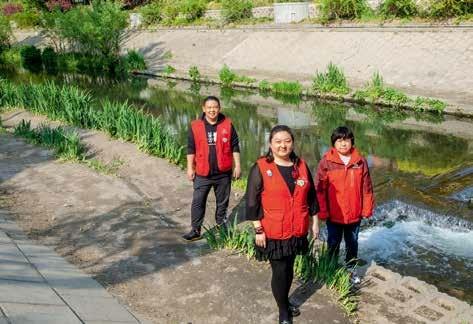China’s River Chief System
2022-06-17byRenWenwei
by Ren Wenwei
W hen people tour Chinas rivers and lakes, they may see boards displaying information about “river chiefs”along the banks, which highlight the duties and commitment of these administrators alongside contact information. At the end of 2018, China fully rolled out the “river chief system,” a water management mechanism that captured the Eastern wisdom of “harnessing water first when governing a country.”
Chinas ancient civilization originated along big rivers. Thus, water means much more to Chinese civilization. In his book China: A Macro History, ChineseAmerican historian Ray Huang argued that it was inevitable for China to set up a unified central government merely to harness the flooding of the Yellow River. Chinas time-honored history was largely a history of river control and management. In the past, river administrators enjoyed different official ranks throughout the dynasties, but their duties shifted from flood prevention to regulation, water transportation, and pollution control, gradually forming a unique system and concept of river management, which inspired the “river chief system”in todays China.

Economic and social development has brought big challenges for water regulators. Nature conservation, agricultural and industrial production, and daily life all vie for water, and different administrative organs have different priorities with agricultural departments focusing on the fishing industry, forestry bureaus looking at wetlands,transportation authorities eyeing shipping, and so on. This situation once hindered concerted effort in water management.
In these circumstances, in the past, Chinas northern rivers were dry while the southern rivers were dirty. For example, back in the 1950s, people could wash vegetables and rice directly with water from Taihu Lake in Jiangsu Province, but by the 1970s, the lakes water quality had severely deteriorated with algae blooms frequent into the 2000s. Finally, in 2007, the worst blue-green algae bloom of all time broke out in the lake, bringing the water crisis to a climax. The crisis made authorities realize that although pollutants were in the water, the roots of the problem were on the banks: administrative problems including mixing different departments rights and obligations and a lack of concrete assessment standards or a reward and punishment mechanism.
This specific crisis inspired the birth of Chinas unique “river chief system.” To overcome the challenge of water pollution, Jiangsus Wuxi municipal government first introduced the “river chief system,” which designated top leaders of related authorities as “river chiefs”responsible for overseeing the management of the citys 64 watercourses flowing into Taihu Lake under their respective jurisdiction. And the quality of the water would be an important indicator for their governing merit assessment. In 2008, the Jiangsu provincial government implemented the “dual-riverchief system” along the 15 main rivers all over the Taihu Lake region. Each water body was to be supervised by one city-level and one provincial-level leader to coordinate efforts to solve the pollution of Taihu Lake. Later, other parts of the country began to follow suit.54574712-9378-48FC-B1DA-12B8C922684B
At the end of 2018, China officially rolled out the “river chief system” nationwide, appointing “chiefs” to every river or lake in the country. The system has become key to river and lake protection, pushing local government heads at all levels to the frontlines. The system designates clear tasks to such river chiefs, who must take concrete actions or be totally accountable for any problems with the rivers.
At present, about 200,000 river chiefs have been appointed across provincial, city, county, and township levels nationwide. If village-level river chiefs are added, the number will top one million. Many targeted training programs were held to improve their governing abilities. The River Chief System Study and Training Center at Hohai University has provided training sessions to more than 20,000 river chiefs, which greatly enhanced the effort. With the implementation of the system, the quality of water in China improved significantly, enabling wider ecological systems to gradually recover.
The “river chief system”has not only helped mediate different departments to make decisions, but also encouraged public supervision and co-management of water systems by the government and the public. Alongside official river chiefs, many civic river chiefs from enterprises, the media, and other social organizations have emerged. The Nanjing Mochou Environmental Protection Association is one of the earliest organizations devoted to the effort. Its volunteer river chiefs patrol local lakes and rivers and encourage citizens to participate in protection work. They even serve as advisors for local governments by leveraging their familiarity with surrounding environments and proximity to public opinion, bridging communication between authorities and locals.

Water is the source of life, foundation of ecology, and a necessity of production. Protecting it requires consensus from the government, enterprises, and the public on a vision that all stakeholders in a river valley share risks, interests, and responsibilities in terms of protecting and restoring the local environment. The “river chief system” may be the most fitting manifestation of Chinas endeavor to protect waters.54574712-9378-48FC-B1DA-12B8C922684B
